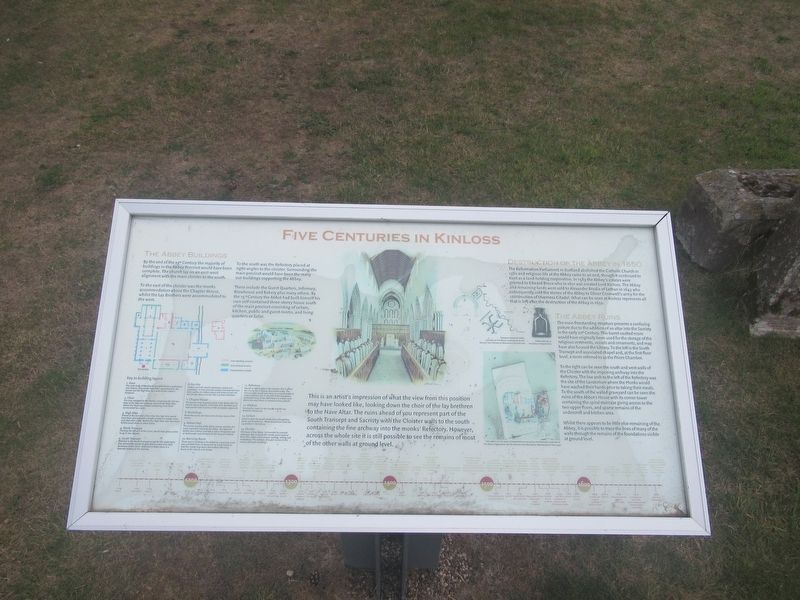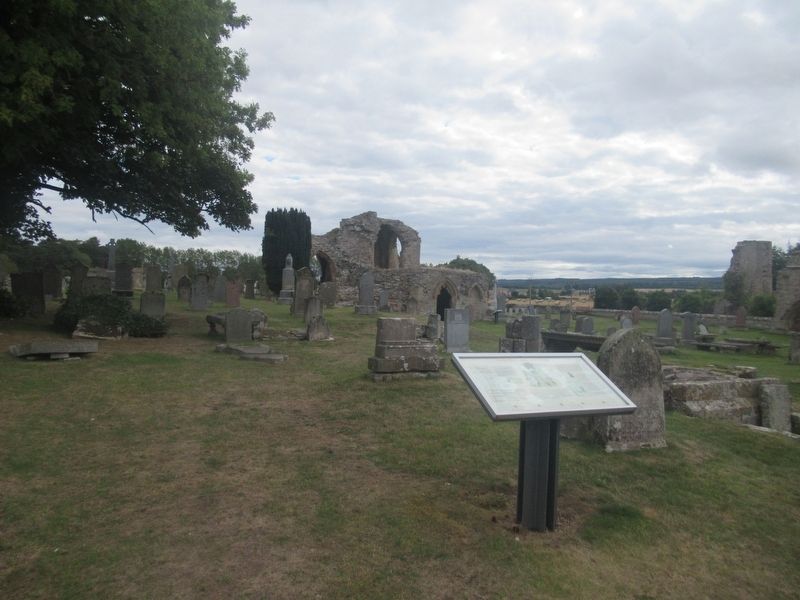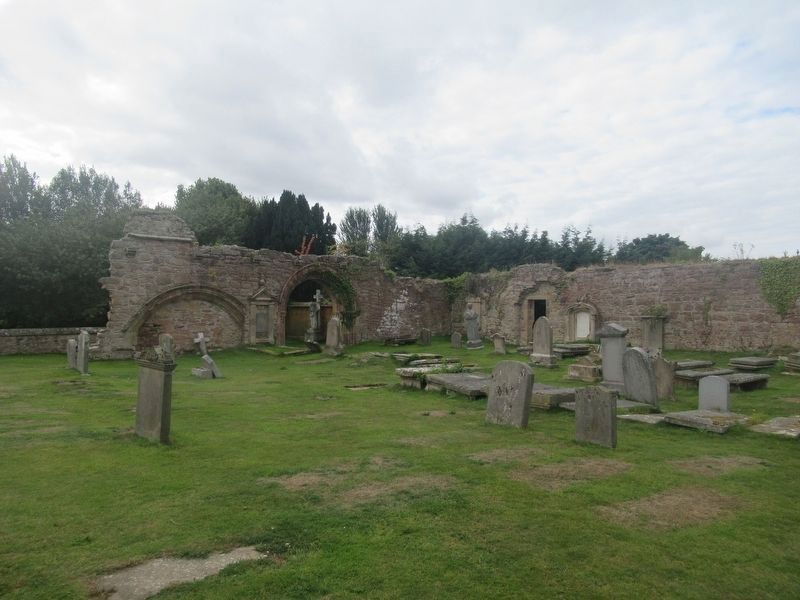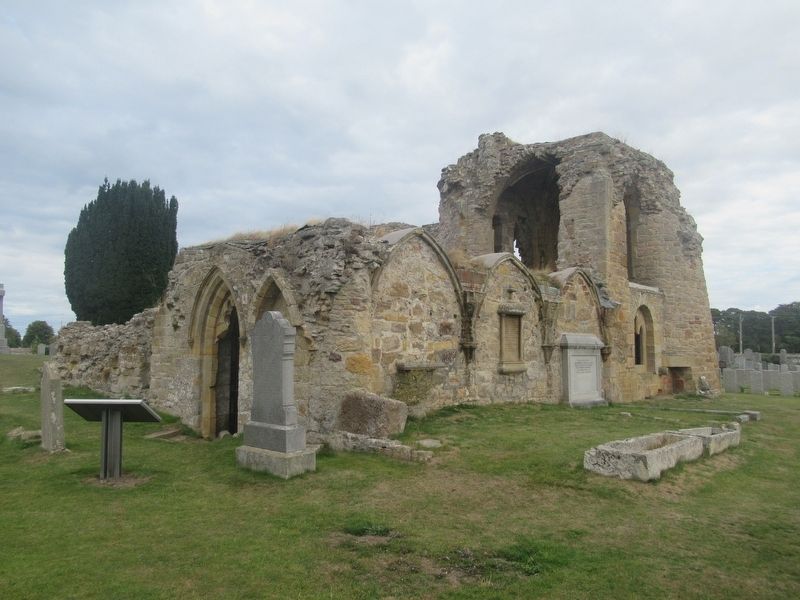Forres in Moray, Scotland, United Kingdom — Northwestern Europe (the British Isles)
Five Centuries in Kinloss
By the end of the 13th Century the majority of buildings in the Abbey Precinct would have been complete. The church lay on an east-west alignment with the main cloister to the south. To the east of the cloister was the monks accommodation above the Chapter House, whilst the Lay Brothers were accommodated to the west.
To the south was the Refectory placed at right-angles to the cloister. Surrounding the main precinct would have been the many out-buildings supporting the Abbey. These include the Guest Quarters, Infirmary, Brewhouse and Bakery plus many others. By the 15thCentury the Abbot had built himself his own self-contained three-storey house south of the main precinct consisting of cellars, kitchen, public and guest rooms, and living quarters or Solar.
Key to building layout
1. Nave The main body of the church occupied by the Lay Brothers and visitors. They would have been separated from the monks and the High Altar by a solid screen called a Pulpitum.
2. Choir The area octupied by the Monks comprising the last two bays of the Nave the crossing area and the High Altar. Above the Choir was a tower containing three bells surmounted by a spire.
3. High Altar Placed at the east end of the Choir the high alter would have been adorned with a simple wooden or pewter cross and plain alter cloth. Behind the High Altar may have been further small altars to other Saints.
4. North Transept Forming the left arm of the Cross, would have given access to up to two chapels.
5. South Transept Identical to the North Transept except for the night stairs that allowed the monks to gain direct access from their dormitory to the Choir. Adjacent to these stairs is a doorway leading to the Sacristy.
6. Sacristy Used to store the church vestments, vessels and ornaments. In later years the western end may well have been used as the Abbey Library with direct access into the Cloister. Above lies the Prior's private chambers.
7. Chapter House The second most important place in the Abbey after the Church where chapters of the Rule of St. Benedict were read and the daily business of the monastery organised.
8. Workshops Below the monks dormitory were the day rooms of the monks.
9. Abbots Hall The private quarters of the Abbot used to entertain the many important visitors to the Abbey. The Abbot of Kinloss was a Mitred Lord with a seat in Parliament and an Ambassador and Emissary for the King of Scotland.
10. Warming Room There was no heating in the Abbey so a warming room was provided from 1st November to Good Friday so that the monks may warm themselves after long hours in the church and cloister.
11. Refectory Placed at right angles to the Cloister, this is where the monks ate in silence three times a day. The Abbot's table would have been on a raised platform at the southern end. To the left of the impressive arched entrance to the Refectory is a smaller arch where the wash basin or Lavatorium was placed.
12. Kitchen Serving the meals for the monks and the Lay Brothers refectories.
13. Cellars Used to store the goods produced on the Abbeys' lands and Brewhouse. Above would have been the Lay Brother's Dormitory.
14. Cloister The heart of the Abbey. Surrounded by covered walkways, this is where the monks spent most of their time, when not in prayer, reading, writing and meditating. The walkway also gave access to the various domestic buildings.
This is an artist's impression of what the view from this position may have looked like, looking down the choir of the lay brethren to the Nave Altar. The ruins ahead of you represent part of the South Transept and Sacristy with the Cloister walls to the south containing the fine archway into the monks' Refectory. However, across the whole site it is still possible to see the remains of of the other walls at ground level.
Destruction of the Abbey in 1650
The Reformation Parliament in Scotland abolished the Catholic Church in 1560 and religious life at the Abbey came to an end, though it continued to exist as a land-holding corporation. In 1583 the Abbey's estates were granted to Edward Bruce who in 1601 was created Lord Kinloss. The Abbey and remaining lands were sold to Alexander Brodie of Lethan in 1643 who subsequently sold the stones of the Abbey to Oliver Cromwell's army for the construction of Inverness Citadel. What can be seen at Kinloss represents all that is left after the destruction of the Abbey in 1650.
The Abbey Ruins
The main freestanding structure presents a confusing picture due to the addition of an altar into the Sacristy in the early 20th Century. This barrel vaulted room would have originally been used for the storage of the religious vestments, vessels and ornaments, and may have also housed the Library. To the left is the South Transept and associated chapel and, at the first floor level, a room referred to as the Priors Chamber.
To the right can be seen the south and west walls of the Cloister with the imposing archway into the Refectory. The low arch to the left of the Refectory was the site of the Lavatorium where the Monks would have washed their hands prior to taking their meals. To the south of the walled graveyard can be seen the ruins of the Abbot's House with its corner tower containing the spiral staircase giving access to the two upper floors, and sparse remains of the undercroft and kitchen area.
Whilst there appears to be little else remaining of the Abbey, it is possible to trace the lines of many of the walls through the remains of the foundations visible at ground level.
Topics. This historical marker is listed in this topic list: Churches & Religion. A significant historical year for this entry is 1650.
Location. 57° 38.035′ N, 3° 34.026′ W. Marker is in Forres, Scotland, in Moray. Marker can be reached from the intersection of Scotland Route B9089 and Route B9011, on the left when traveling east. Touch for map. Marker is in this post office area: Forres, Scotland IV36 3TL, United Kingdom. Touch for directions.
Other nearby markers. At least 8 other markers are within 10 kilometers of this marker, measured as the crow flies. Kinloss Abbey (a few steps from this marker); The Cistercians of Kinloss (within shouting distance of this marker); Kinloss War Memorial (approx. 3.6 kilometers away); Findhorn Tercentenary (approx. 3.6 kilometers away); Benjamin MacLean (approx. 8.8 kilometers away); Burghead War Memorial (approx. 8.8 kilometers away); The Harvest Reaper (approx. 8.9 kilometers away); Fortune’s Beacon (approx. 9 kilometers away). Touch for a list and map of all markers in Forres.
Also see . . . Kinloss Abbey on Wikipedia. (Submitted on January 1, 2019, by Michael Herrick of Southbury, Connecticut.)
Credits. This page was last revised on January 27, 2022. It was originally submitted on January 1, 2019, by Michael Herrick of Southbury, Connecticut. This page has been viewed 81 times since then and 4 times this year. Photos: 1, 2, 3, 4. submitted on January 1, 2019, by Michael Herrick of Southbury, Connecticut.



